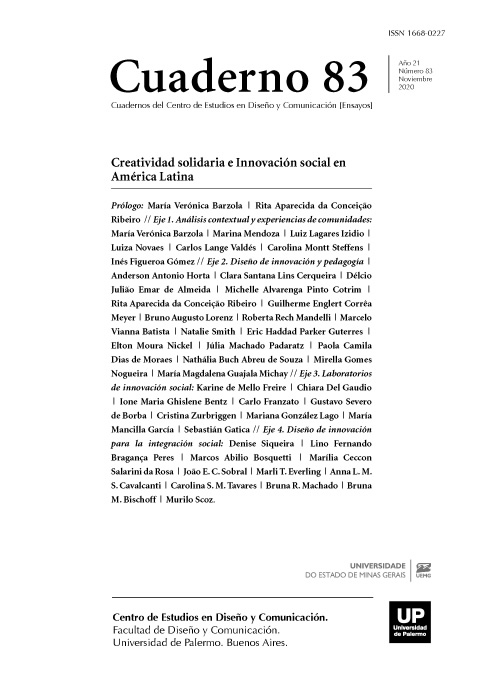A inovação social potencializada por conceitos semióticos da Tríade do Design no processo criativo artesanal
Abstract
Thinking about cross-sectional and hybrid design is necessary when it is present in the context of creative production in social projects. In this place of creation, the language of design becomes the mediator of social relations, existing linked to the processes of transformations, and being constructed from the dialectic between the social and the individual. In social projects with craft production, creative process workshops function as a method of aesthetic and visual sensitization of the participants, always allying theoretical classes to practical activities. These creation workshops, mediated by designers, allow the expansion of the aesthetic and cultural repertoire of the participants of this type of social project. Therefore, it is believed to be extremely important, so that artisans can create products capable and appropriate to represent them, the use of a process of contextual re-signification of the territory where the products are developed, based on semiotic concepts. The methodology used in the research included an analysis, based on a case study based on creative process workshops of the Aglomerado da Serra - ASAS Craft Solidarity project. The study sought to identify relationships between the use of concepts of semiotics and the creative evolution of the artisans of the cited project and, consequently, indications that strengthened or not the idea of design as a vector of social transformation.
References
Barroso, E. (1999). “Design, identidade cultural e artesanato”, Primeira Jornada Iberoamericana de Design no Artesanato. Disponível em www.eduardobarroso.com.br Acesso em 23/06/2015.
Bonsiepe, G. (1997). Design do material ao digital. Florianópolis: FIESC/IEL.
Braida, F. e Nojima, V. (2014). Por que design é linguagem? Rio de Janeiro: Rio Book’s.
Braida, F. e Nojima, V. (2014). Tríades do Design: Um olhar sobre a forma, o significado e a função. Rio de Janeiro: Rio Book’s.
Lassance Júnior, A. e Pedreira, J. (2004). “Tecnologias sociais e políticas públicas”, em Tecnologia social - uma estratégia para o desenvolvimento. Rio de Janeiro: Fundação Banco do Brasil.
Maffesoli, M. (2001). Sobre o nomadismo: vagabundagens pós-modernas. Rio de Janeiro: Record.
Manzini, E. (2008). Design para a inovação social e sustentabilidade: comunidades criativas, organizações colaborativas e novas redes projetuais. [coordenação de tradução Carla Cipolla; equipe Elisa Spampinato, Aline Lys Silva]. Rio de Janeiro: E-papers.
Nojima, V. (2006). “Os estudos das linguagens como apoio aos processos metodológicos do design”, em Coelho, L. (2006). Design método. Rio de Janeiro: PUC, pp. 123-134.
Rena, N. (2010). Territórios aglomerados. Belo Horizonte: FUMEC. Szaniecki, B. (2007). Estética da multidão. Rio de Janeiro: Civilização Brasileira
Los autores/as que publiquen en esta revista ceden los derechos de autor y de publicación a "Cuadernos del Centro de Estudios de Diseño y Comunicación", Aceptando el registro de su trabajo bajo una licencia de atribución de Creative Commons, que permite a terceros utilizar lo publicado siempre que de el crédito pertinente a los autores y a esta revista.


